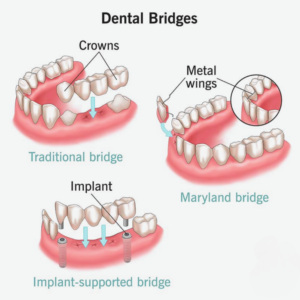Crown Bridge
What to expect?

Dental bridges serve to replace missing teeth, whether it’s a single tooth or multiple teeth in a row.
As the name suggests, a dental bridge “bridges the gap” in your smile. Dentists can customize bridges to match the color of your natural teeth.
Components of a dental bridge include:
– Abutments: These are the supports for your dental bridge, which can be natural teeth or small connector posts used in implant-supported bridges.
– Pontics: These are the artificial teeth that fill the gap left by missing teeth.
Your bridge may consist of one or more abutments and pontics, depending on your situation.
Types of Dental Bridges:
1. Traditional Dental Bridge: This common type has dental crowns on both ends with pontics in between. It’s used when there are healthy teeth on both sides of the gap.
2. Cantilever Dental Bridge: Similar to the traditional bridge but with a crown only on one end, used when there are teeth only on one side of the gap.
3. Maryland Dental Bridge: Uses metal wings bonded to the back of neighboring teeth, typically used for front teeth.
4. Implant-Supported Bridge: This type uses dental implants instead of natural teeth and is used for replacing three or more teeth in a row.
Factors Determining Bridge Type:
Dentists consider factors like age, the number of missing teeth, gap size, condition of adjacent teeth, and overall oral health.
Procedure Details:
– Traditional or Cantilever Bridge: Involves reshaping abutment teeth, taking impressions, and placing a temporary bridge until the final one is ready.
– Maryland Bridge: Involves preparing teeth for metal wings, taking impressions, and bonding the bridge in place.
– Implant-Supported Bridge: Requires placing implants, waiting for osseointegration, and then attaching the bridge.
Pros and Cons:
– Pros: Natural-looking, restores function, prevents teeth from shifting.
– Cons: Can be weakened by damage to abutment teeth, may cause gum issues if not properly cleaned.
Recovery and Longevity:
Recovery takes one to two weeks, and bridges typically last five to 15 years with proper care. They are permanent but may need replacement over time.
Care Tips:
Brush and floss daily, use fluoride toothpaste, clean under the bridge, avoid hard foods, and visit your dentist regularly.
When to Contact Your Dentist:
If your bridge is loose, cracked, causes pain, or if you have gum issues.
Additional Questions:
– Bridge vs. Implant: Implants last longer and preserve bone better, but the best option depends on individual needs.
– Ideal Age: Typically not placed in those under 17 or 18, except in special cases.
– Number of Teeth: Bridges usually replace one to three teeth but can replace up to four with sufficient support.
– Waiting Period: Replace missing teeth promptly to prevent shifting, but post-extraction healing might be necessary.
– Pain: The procedure shouldn’t hurt due to local anesthesia.
– Real Feel: Bridges may take some getting used to but should eventually feel natural.
– Removal and Recementing: Possible if loose, but the bridge may break if removed for other reasons, requiring a new bridge.
How much does it cost ?


